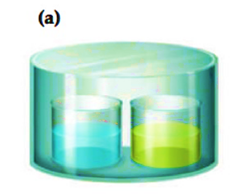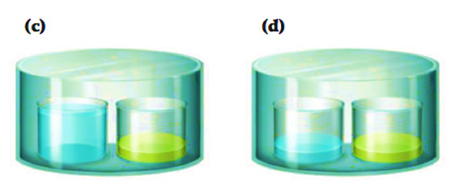
Chemistry - Modified MasteringChemistry
7th Edition
ISBN: 9780133892321
Author: McMurry
Publisher: PEARSON
expand_more
expand_more
format_list_bulleted
Concept explainers
Question
Chapter 12, Problem 12.35CP
Interpretation Introduction
Interpretation:
To choose the beaker which shows the correct representation after some time.
Concept introduction:
Vapor pressure is defined as the amount of pressure exerted by the vapor when the liquid is in equlibrium with it vapor in a closed container.
Water is more volatile than
Given:
Two beakers filled with pure water (blue) and with

Options to choose from:

Expert Solution & Answer
Want to see the full answer?
Check out a sample textbook solution
Students have asked these similar questions
Curved arrows are used to illustrate the flow of electrons. Using
the provided starting and product structures, draw the curved
electron-pushing arrows for the following reaction or
mechanistic step(s).
Be sure to account for all bond-breaking and bond-making
steps.
:0:
NaOH, H₂O
00:4
Na O
heat
NaO
Select to Add Arrows
Select to Add Arrows
:0:
Na
a
NaOH, H2O
:0:
NaOH,
H2O
heat
heat
Na
ONH
Select to Add Arrows
Curved arrows are used to illustrate the flow of electrons. Using
the provided starting and product structures, draw the curved
electron-pushing arrows for the following reaction or
mechanistic step(s).
Be sure to account for all bond-breaking and bond-making
steps.
H
CH3NH3+
:0:
:0:
HO
CH3NH2
HH
iSelect to Add Arrows i
Select to Add Arrows i
HH
CH3NH3+
CH3NH2
Select to Add Arrows i
CH3NH3
CH3NH2
ايكدا
HH
Select to Add Arrows
The reaction is carried out with gases: A → B + C at 300 K. The
total pressure is measured as a function of time (table). If the
reaction order is 2, calculate the rate or kinetic constant k (in
mol-1 L s¹)
Ptotal (atm) 492 676 760 808 861
t(s)
0 600 1200 1800 3000
Chapter 12 Solutions
Chemistry - Modified MasteringChemistry
Ch. 12 - Prob. 12.1PCh. 12 - Prob. 12.2ACh. 12 - Prob. 12.3PCh. 12 - Prob. 12.4ACh. 12 - PRACTICE 12.5 A 50.0 mL sample of drinking water...Ch. 12 - APPLY 12.6 The legal limit for human exposure to...Ch. 12 - PRACTICE 12.7 What mass in grams of a 0.500 m...Ch. 12 - APPLY 12.8 What is the molality of a solution...Ch. 12 - PRACTICE 12.9 The density at 20°C of a 0.500 M...Ch. 12 - APPLY 12.10 The density at 20°C of a 0.258 m...
Ch. 12 - Prob. 12.11PCh. 12 - APPLY 12.12 Use the Henry’s law constant you...Ch. 12 - PRACTICE 12.13 What is the vapor pressure in mm Hg...Ch. 12 - APPLY 12.14 A solution made by dissolving 8.110 g...Ch. 12 - Prob. 12.15PCh. 12 - Conceptual APPLY 12.16 The following diagram shows...Ch. 12 - PRACTICE 12.17 What is the vapor pressure of the...Ch. 12 - Conceptual APPLY 12.18 The following diagram shows...Ch. 12 - Prob. 12.19PCh. 12 - APPLY 12.20 The following phase diagram shows a...Ch. 12 - Prob. 12.21PCh. 12 - APPLY 12.22 Cells in the human eye have an osmotic...Ch. 12 - PRACTICE 12.23 A solution prepared by dissolving...Ch. 12 - Prob. 12.24ACh. 12 - PROBLEM 12.25 What is the difference between a...Ch. 12 - PROBLEM 12.26 Urea has a high solubility in blood...Ch. 12 - Prob. 12.27PCh. 12 - Prob. 12.28PCh. 12 - Many people take vitamin supplements to promote...Ch. 12 - Prob. 12.30CPCh. 12 - Prob. 12.31CPCh. 12 - Prob. 12.32CPCh. 12 - Prob. 12.33CPCh. 12 - Prob. 12.34CPCh. 12 - Prob. 12.35CPCh. 12 - Prob. 12.36CPCh. 12 - Prob. 12.37CPCh. 12 - Prob. 12.38CPCh. 12 - Prob. 12.39CPCh. 12 - Prob. 12.40SPCh. 12 - 12.41 Why do ionic substances with higher lattice...Ch. 12 - Prob. 12.42SPCh. 12 - Prob. 12.43SPCh. 12 - Classify the strongest type of intermolecular...Ch. 12 - Classify the strongest type of intermolecular...Ch. 12 - Prob. 12.46SPCh. 12 - Prob. 12.47SPCh. 12 - Prob. 12.48SPCh. 12 - Prob. 12.49SPCh. 12 - Prob. 12.50SPCh. 12 - Prob. 12.51SPCh. 12 - Prob. 12.52SPCh. 12 - Prob. 12.53SPCh. 12 - Prob. 12.54SPCh. 12 - Pentyl alcohol (Problem 12.54) is miscible with...Ch. 12 - Prob. 12.56SPCh. 12 - 12.57 The dissolution of NH4ClO4(s) in water is...Ch. 12 - Prob. 12.58SPCh. 12 - Prob. 12.59SPCh. 12 - Prob. 12.60SPCh. 12 - Prob. 12.61SPCh. 12 - Prob. 12.62SPCh. 12 - Prob. 12.63SPCh. 12 - Prob. 12.64SPCh. 12 - Prob. 12.65SPCh. 12 - Prob. 12.66SPCh. 12 - Prob. 12.67SPCh. 12 - Prob. 12.68SPCh. 12 - Prob. 12.69SPCh. 12 - Prob. 12.70SPCh. 12 - Prob. 12.71SPCh. 12 - Prob. 12.72SPCh. 12 - Prob. 12.73SPCh. 12 - Prob. 12.74SPCh. 12 - Prob. 12.75SPCh. 12 - Ethylene glycol, C2H6O2, is the principal...Ch. 12 - Ethylene glycol, C2H6O2, is a colorless liquid...Ch. 12 - Prob. 12.78SPCh. 12 - Prob. 12.79SPCh. 12 - Prob. 12.80SPCh. 12 - Prob. 12.81SPCh. 12 - Prob. 12.82SPCh. 12 - Prob. 12.83SPCh. 12 - Prob. 12.84SPCh. 12 - Hydrogen sulfide, H2S, is a toxic gas responsible...Ch. 12 - Prob. 12.86SPCh. 12 - Prob. 12.87SPCh. 12 - Prob. 12.88SPCh. 12 - Prob. 12.89SPCh. 12 - Prob. 12.90SPCh. 12 - Prob. 12.91SPCh. 12 - Prob. 12.92SPCh. 12 - Prob. 12.93SPCh. 12 - Prob. 12.94SPCh. 12 - Prob. 12.95SPCh. 12 - Prob. 12.96SPCh. 12 - Prob. 12.97SPCh. 12 - Prob. 12.98SPCh. 12 - Prob. 12.99SPCh. 12 - Prob. 12.100SPCh. 12 - Prob. 12.101SPCh. 12 - Prob. 12.102SPCh. 12 - Prob. 12.103SPCh. 12 - Prob. 12.104SPCh. 12 - Prob. 12.105SPCh. 12 - Prob. 12.106SPCh. 12 - Prob. 12.107SPCh. 12 - Prob. 12.108SPCh. 12 - Prob. 12.109SPCh. 12 - Prob. 12.110SPCh. 12 - Prob. 12.111SPCh. 12 - Prob. 12.112SPCh. 12 - Prob. 12.113SPCh. 12 - Prob. 12.114SPCh. 12 - Prob. 12.115SPCh. 12 - Prob. 12.116SPCh. 12 - Prob. 12.117SPCh. 12 - Prob. 12.118SPCh. 12 - Prob. 12.119SPCh. 12 - Prob. 12.120SPCh. 12 - Prob. 12.121SPCh. 12 - Prob. 12.122SPCh. 12 - Prob. 12.123SPCh. 12 - Prob. 12.124SPCh. 12 - Prob. 12.125SPCh. 12 - Prob. 12.126SPCh. 12 - Prob. 12.127SPCh. 12 - Prob. 12.128SPCh. 12 - Prob. 12.129SPCh. 12 - Prob. 12.130CPCh. 12 - Prob. 12.131CPCh. 12 - Prob. 12.132CPCh. 12 - Prob. 12.133CPCh. 12 - Prob. 12.134CPCh. 12 - Prob. 12.135CPCh. 12 - Prob. 12.136CPCh. 12 - Prob. 12.137CPCh. 12 - Prob. 12.138CPCh. 12 - There’s actually much more in seawater than just...Ch. 12 - Prob. 12.140CPCh. 12 - Prob. 12.141CPCh. 12 - Prob. 12.142CPCh. 12 - Prob. 12.143CPCh. 12 - Prob. 12.144CPCh. 12 - What is the value of the van’t Hoff factor for KCI...Ch. 12 - Prob. 12.146CPCh. 12 - Prob. 12.147CPCh. 12 - Prob. 12.148CPCh. 12 - Prob. 12.149CPCh. 12 - Prob. 12.150CPCh. 12 - Prob. 12.151CPCh. 12 - An aqueous solution of a certain organic compound...Ch. 12 - Prob. 12.153CPCh. 12 - Prob. 12.154CPCh. 12 - Prob. 12.155CPCh. 12 - Prob. 12.156CPCh. 12 - Prob. 12.157CPCh. 12 - Prob. 12.158CPCh. 12 - Prob. 12.159CPCh. 12 - Prob. 12.160MPCh. 12 - Prob. 12.161MPCh. 12 - Prob. 12.162MPCh. 12 - Prob. 12.163MPCh. 12 - Prob. 12.164MP
Knowledge Booster
Learn more about
Need a deep-dive on the concept behind this application? Look no further. Learn more about this topic, chemistry and related others by exploring similar questions and additional content below.Similar questions
- can someone give a description of this NMR including whether its a triplt singlet doublet where the peak is around at ppm and what functional group it representsarrow_forward1. Determine the relationship between the following molecules as identical, diastereomers, or enantiomers (6 points, 2 points each). OH OH OH A-A OH HOT HO- ACHN and HO- ACHN OH HO HO ° OH and OH OH SH and ...SHarrow_forward20,0 Complete the electron pushing mechanism to y drawing the necomery unicaciones and carved on for Step 1: Add curved arms for the tint step, traiment with NalilĻ. The Nation 458 Step 2: Added for the second step, inalment with), how the "counterion bar Step 3: Daw the products of the last simplom organic and one incoganic spacient, including all nonbondingarrow_forward
- please provide the structure for this problem, thank you!arrow_forwardDraw the Fischer projection from the skeletal structure shown below. HO OH OH OH OH H Q Drawing Atoms, Bonds and Rings Charges I ☐ T HO H H OH HO I CH2OH H OH Drag H OH -CH2OH CHO -COOH Undo Reset Remove Donearrow_forwardplease provide the structure for this problem, thank youarrow_forward
- presented by Morallen Lig Intermine the hand product for the given mution by adding atoms, bonds, nonhonding diarion panda скуль Step 3: Comp the draw the product Step 2: Agama workup Compithe 429 ملولةarrow_forwardReaction A 0,0arrow_forwardpresented by Morillon Leaning Predict the organic product for the min кусур HSC Adithane carved arnown to come than that to the condon slchroruis in acid in in aquishri with ноюarrow_forward
- 6.15PM Sun Mar 30 K Draw the major product of this reaction. Include any relevant stereochemistry. Ignore inorganic byproducts. Problem 1 of O H [PhзPCH2CH3]*C|¯ NaH Drawing > Q Atoms, Bonds and Draw or tap a nearrow_forward8:17 PM Sun Mar 30 Draw the major product of this reaction. Ignore inorganic byproducts. HSCH2CH2CH2SH, BF3 Probler Drawing Ato Bonds Clarrow_forwardpresented by Mr L How the coprion. (Il Done in no wraction, dew the starting redential) доarrow_forward
arrow_back_ios
SEE MORE QUESTIONS
arrow_forward_ios
Recommended textbooks for you
 ChemistryChemistryISBN:9781305957404Author:Steven S. Zumdahl, Susan A. Zumdahl, Donald J. DeCostePublisher:Cengage Learning
ChemistryChemistryISBN:9781305957404Author:Steven S. Zumdahl, Susan A. Zumdahl, Donald J. DeCostePublisher:Cengage Learning ChemistryChemistryISBN:9781259911156Author:Raymond Chang Dr., Jason Overby ProfessorPublisher:McGraw-Hill Education
ChemistryChemistryISBN:9781259911156Author:Raymond Chang Dr., Jason Overby ProfessorPublisher:McGraw-Hill Education Principles of Instrumental AnalysisChemistryISBN:9781305577213Author:Douglas A. Skoog, F. James Holler, Stanley R. CrouchPublisher:Cengage Learning
Principles of Instrumental AnalysisChemistryISBN:9781305577213Author:Douglas A. Skoog, F. James Holler, Stanley R. CrouchPublisher:Cengage Learning Organic ChemistryChemistryISBN:9780078021558Author:Janice Gorzynski Smith Dr.Publisher:McGraw-Hill Education
Organic ChemistryChemistryISBN:9780078021558Author:Janice Gorzynski Smith Dr.Publisher:McGraw-Hill Education Chemistry: Principles and ReactionsChemistryISBN:9781305079373Author:William L. Masterton, Cecile N. HurleyPublisher:Cengage Learning
Chemistry: Principles and ReactionsChemistryISBN:9781305079373Author:William L. Masterton, Cecile N. HurleyPublisher:Cengage Learning Elementary Principles of Chemical Processes, Bind...ChemistryISBN:9781118431221Author:Richard M. Felder, Ronald W. Rousseau, Lisa G. BullardPublisher:WILEY
Elementary Principles of Chemical Processes, Bind...ChemistryISBN:9781118431221Author:Richard M. Felder, Ronald W. Rousseau, Lisa G. BullardPublisher:WILEY

Chemistry
Chemistry
ISBN:9781305957404
Author:Steven S. Zumdahl, Susan A. Zumdahl, Donald J. DeCoste
Publisher:Cengage Learning

Chemistry
Chemistry
ISBN:9781259911156
Author:Raymond Chang Dr., Jason Overby Professor
Publisher:McGraw-Hill Education

Principles of Instrumental Analysis
Chemistry
ISBN:9781305577213
Author:Douglas A. Skoog, F. James Holler, Stanley R. Crouch
Publisher:Cengage Learning

Organic Chemistry
Chemistry
ISBN:9780078021558
Author:Janice Gorzynski Smith Dr.
Publisher:McGraw-Hill Education

Chemistry: Principles and Reactions
Chemistry
ISBN:9781305079373
Author:William L. Masterton, Cecile N. Hurley
Publisher:Cengage Learning

Elementary Principles of Chemical Processes, Bind...
Chemistry
ISBN:9781118431221
Author:Richard M. Felder, Ronald W. Rousseau, Lisa G. Bullard
Publisher:WILEY
Solutions: Crash Course Chemistry #27; Author: Crash Course;https://www.youtube.com/watch?v=9h2f1Bjr0p4;License: Standard YouTube License, CC-BY